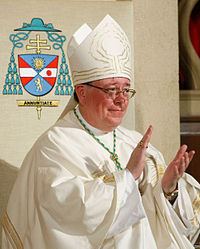Territory Entire country Established 1833 Area 2,586 km² | ||
 | ||
Population- Total- Catholics (as of 2013)537,000411,000 (76.5%) Cathedral | ||
The Roman Catholic Archdiocese of Luxembourg (Latin: Archidioecesis Luxemburgensis) is an archdiocese of the Latin Rite of the Roman Catholic Church in the Grand Duchy of Luxembourg, comprising the entire Grand Duchy. The seat of the Archdiocese is the Cathedral of Notre Dame in the city of Luxembourg, and since 2011 the Archbishop is Jean-Claude Hollerich.
Contents
History
Before the French Revolution, the southern part of the territory of what is now the archdiocese belonged to the Roman Catholic Diocese of Trier (then an archbishopric) and the northern part to the Roman Catholic Diocese of Liège. After the 1815 Congress of Vienna, which raised Luxembourg to the rank of Grand Duchy in personal union with the crown of the Netherlands, Pope Pius VII attached the territory to the Roman Catholic Diocese of Namur.
From 25 December 1833 the area was entrusted to a priest, acting as apostolic prefect, who became its first apostolic vicar, when on 2 June 1840 the territory became an apostolic vicariate, a jurisdiction normally headed by a titular bishop. It became a fully fledged diocese on 27 December 1870, without being incorporated into any ecclesiastical province. On 23 April 1988, it was raised to the rank of archdiocese.
The current Archbishop of Luxembourg, since 12 July 2011, is Jean-Claude Hollerich
Situation
The archdiocese is not a metropolitan see, having no suffragans.
At the end of 2010, the archdiocese estimated its membership at 396,500, out of a total population of 502,000, and reported that it had 275 parishes, 151 diocesan priests, 56 religious priests, 6 permanent deacons, 70 religious brothers and 566 religious sisters. However, the numbers of Catholics actually attending Mass is on the decline, as reflected by amalgamations of parishes and deconsecrations of churches.
Currently under discussion is the disestablishment of the Church in Luxembourg, whereby the State would cease to hold financial responsibility for the Church.
A 1996 survey (not a census) reported Catholics 88%, including the royal family; Protestants and similar 1%; other religions 1%; no religion 9%; no reply 1%.
